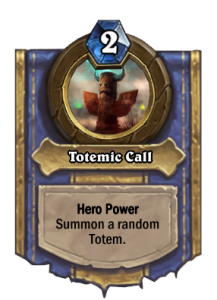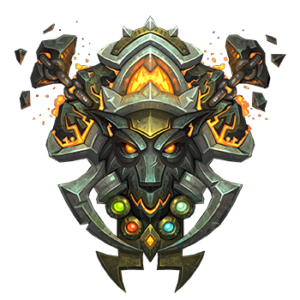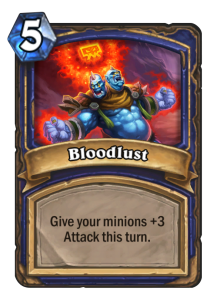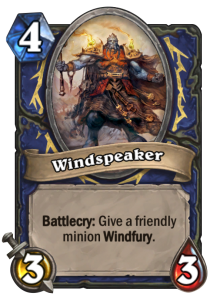Shamans are the mystics that communicate with Elements – air, earth, fire, and water. Elements, by their nature, are very chaotic, and only Shamans are able to tame them and bring balance to the disorder. Probably their most recognizable tools are the powerful totems, where they can place some of the elements’ power. They summon totems on the battlefield to help allies or wound foes.
Totems aren’t the only way to harness the power of elements. Shamans can use them to harm their foes directly, by striking them with lightning bolts, bursts of lava, or even powerful earthquakes. Elements can also be used to Imbue the Shaman’s weapon and make it stronger and, depending on the element, deal extra damage (Flametongue), add a second hit (Windfury) or slow down the attacked enemy (Frostbrand). Enhancement Shamans can also summon a pair of powerful spirit wolves to fight at their side.
However, what makes Shaman a truly hybrid class is their ability to heal. They call upon the spirits of their ancestors and the elements of water and earth to mend the wounds of their allies. Shamans can use a wave of energy to heal a single target, but can also call upon a healing rain to coat a target arena and restore vital forces to anyone inside. Shamans can also use some protection spells like providing an earth shield that will reduce damage taken and provide healing with every blow.
In Hearthstone, Shaman class is represented by the Thrall. Players can also unlock an alternative, cosmetic Shaman Hero – Morgl the Oracle.
Themes and Mechanics

Shaman’s Hero Power is Totemic Call. After using it, the player summons a random totem to the battlefield. It’s the only Hero Power with an element of randomness – there are four basic totems, which means that there is exactly 25% chance to summon any of them (assuming no totems are on the board). The four options are Healing Totem, Searing Totem, Stoneclaw Totem and Wrath of Air Totem. When you already have one of the totems, you can’t roll it again with the Hero Power, so the chance to get a specific one goes up to 33%, 50%, and 100% when you have one, two and three totems on the board, respectively. Shaman’s Hero Power can be the strongest or the weakest one depending on the situation and the random roll. Sometimes the totems are game-changing (like +1 Spell Damage before AoE or Taunt when the opponent has lethal), but other times they’re completely useless.
Shaman’s unique mechanic is Overload. It’s an extra cost to the card that you don’t pay right away – you pay it next turn by reducing the number of mana available to you. For example, if you play a card with Overload (2) on Turn 5, you’ll only have four points of mana available on Turn 6 instead of the six you should have. If you add the basic and Overload cost, the cards with this effect are usually pretty weak. However, the reason why they can be powerful is the fact that you can play them earlier than you normally could. Flamewreathed Faceless is a great example – 6 mana 7/7 would not see any play (it’s just a slightly better Boulderfist Ogre). However, the fact that Shaman can drop it on Turn 4 makes it a pretty strong card. Similarly, Elemental Destruction is a strong card, because you can play it as soon as Turn 3. Even though you’d skip the next turn if you’d play it so early, it can save one’s skin by dealing with an early big board.
There are also some cards that synergize with Overload – some grow stronger when the Overload card is played (Tunnel Trogg, Unbound Elemental) or are able to remove the Overloaded mana (Lava Shock, Eternal Sentinel).
There is also a tribe that’s unique to the Shaman – Totem. Besides the four basic totems, there are more cards with that tag and multiple cards that synergize with them. Other cards with Totem tribe are, for example: Flametongue Totem, Totem Golem, Primalfin Totem, Vitality Totem or Mana Tide Totem. As you can see, they have a wide range of the effects and can come handy in many different situations. On top of that, playing multiple totems has great synergy with multiple Shaman cards: Totemic Might, Primal Fusion, Draenei Totemcarver, Thunder Bluff Valiant and Thing from Below. It is possible to build a whole Shaman deck around the Totem synergies, although not in Standard, since some of those cards have already rotated to Wild.
Learn more about Shaman in World of Warcraft via Wowhead’s class guides: Elemental Shaman Guide, Enhancement Shaman Guide, or the Restoration Shaman Guide!
Another thing that’s unique to Shaman are the Evolve effects. Evolving a minion means changing it into a random one with a higher mana cost. While it’s not a big theme yet, it might see further development in the future. Right now there are four cards that can evolve any of your minions on the battlefield – Evolve, Unstable Evolution, Thrall, Deathseer and Master of Evolution. Lotus Illusionist can kind of evolve herself after attacking the opponent’s Hero. There is also an opposite effect that Shaman can place on the opponent’s minions – Devolve.
Even though the mechanic isn’t exactly unique to Shaman (as the Druids can do a similar thing), Bloodlust is a big theme in the Shaman. There are whole decks built around this card. It’s an incredibly powerful finisher that grows stronger with the amount of minions Shaman has on the board. Thanks to the ability to generate multiple tokens through the Hero Power and some other cards (Primalfin Totem, Maelstrom Portal, Jade cards), it’s very easy to flood the board as a Shaman. And Bloodlust can deal up to 21 damage for just 5 mana.
There are also some ongoing themes when it comes to the Shaman cards. When new cards are released, there is a significant chance that some of them will fall into one of those categories:
- Elemental – It’s the Shaman’s secondary tribe. Unlike Totems the Elemental tribe isn’t unique to the class, but Shaman currently has the heaviest focus on Elemental cards. The class already had multiple Elemental cards, even before the tribe’s introduction in the Journey to Un’Goro expansion. Right now Shamans have both cards that are Elementals (Fire Elemental, Hot Spring Guardian) and those which synergize with Elementals (Fire Plume Harbinger, Stone Sentinel). Shamans also have access to the most powerful Elemental synergy minion in the whole game – Kalimos, Primal Lord.
- AoE Damage – Shamans are well-known for their board clears. It started with the Lightning Storm in the Classic set, but them Shamans received more and more useful board sweepers, like Elemental Destruction, Maelstrom Portal and Volcano. On top of that, while not exactly an AoE, Devolve is another powerful tool to deal with the big boards. Especially if the minions are buffed or have some sort of powerful Deathrattles – it’s heavily random, but devolving them should decrease their quality significantly.
- Murloc – Murlocs are the Shaman’s tertiary tribe. While there was never a huge focus on the Murloc cards in Shaman, the tribe gets some support every second expansion or so. There are some cards that summon Murlocs or synergize with Murlocs, even though most have already rotated into the Wild: Siltfin Spiritwalker, Call in the Finishers, Primalfin Totem, Everyfin is Awesome and Neptulon. The Shaman’s Quest from Journey to Un’Goro is also based around the Murlocs – Unite the Murlocs.
- Healing – While not as good as Paladins or Priests, Shamans can also heal and they get some healing cards every now and then. Unlike the other classes, Shaman’s healing is usually printed on the minions and not spells. While there are some healing spells, like Healing Wave, Tidal Surge and Healing Rain (and Ancestral Spirit to a certain extent, but it can only heal a minion), most of the Shaman’s healing comes in a form of Battlecry, End of Turn or Ongoing effects on the minions. E.g. Vitality Totem, Hot Spring Guardian, Jinyu Waterspeaker, Hallazeal the Ascended, and Kalimos, Primal Lord.
- Freeze – Shaman is one of the two classes with access to class Freeze tools (the other one is Mage). Shaman could always use Frost Shock, however Knights of the Frozen Throne expansion added more Freeze support to the class, with cards that can Freeze (Brrrloc, Avalanche, Voodoo Hexxer) and Freeze synergies (Ice Breaker, Moorabi). It’s hard to say whether they will continue to print more Freeze cards in the Shaman or if it was only an one-time experiment.
Strengths and Weaknesses
Strengths:
 Board Control Tools – Shamans are great at controlling the board. Hex is probably the most powerful single target removal in the entire game (as it has no restrictions, it denies Deathrattles and Divine Shields, and the only downside is creating a 0/1 Taunt for the opponent). Shamans have access to many more single target removals like Jade Lightning, Lightning Bolt, Stormcrack or Tidal Surge. On top of that, the class has a lot of really powerful AoE effects – Maelstrom Portal is very effective against small minions, Lightning Storm against mid-sized and Volcano/Elemental Destruction against big ones. Some minions like Fire Elemental or Kalimos, Primal Lord also come with the removal effects attached. All of this combined makes Shaman the class that can easily control the board for the extended periods of time.
Board Control Tools – Shamans are great at controlling the board. Hex is probably the most powerful single target removal in the entire game (as it has no restrictions, it denies Deathrattles and Divine Shields, and the only downside is creating a 0/1 Taunt for the opponent). Shamans have access to many more single target removals like Jade Lightning, Lightning Bolt, Stormcrack or Tidal Surge. On top of that, the class has a lot of really powerful AoE effects – Maelstrom Portal is very effective against small minions, Lightning Storm against mid-sized and Volcano/Elemental Destruction against big ones. Some minions like Fire Elemental or Kalimos, Primal Lord also come with the removal effects attached. All of this combined makes Shaman the class that can easily control the board for the extended periods of time.- Snowball Potential – When you play against Shaman, you absolutely have to clear everything they play. Even a small, 1/1 minion can suddenly become something better or trade up. Thanks to the attack boost effects of Flametongue Totem and Bloodlust, as well as the potential to Evolve minions, Shamans can turn seemingly harmless boards into deadly threats. When you leave their board unanswered for even a turn or two, they can easily snowball it out of control.
- Burst Damage – Shamans are well-known for their high burst potential. Outside of the slowest Shaman decks which focus more on board control, Shamans are the masters of explosive game finishers. Bloodlust is one of the most common finishers – the card usually deals at least 12 or 15 damage for just 5 mana, but it has the ability to go as high as 21 with the full board. Other than that, Shamans have some cheap, high damage spells with Overload – Crackle, Lava Burst, Lightning Bolt. Though the Overload part doesn’t really matter if the opponent is dead. Doomhammer is another deadly card – it can deal up to 16 damage by itself over the course of four turns. However, it’s even more scary when combined with Rockbiter Weapon – two copies casted on the Shaman equipped with Doomhammer translate into 16 points of burst damage.
Weaknesses:
- Very Reliant on the Board – Shamans are nothing without the board and that’s their main weakness. It might not be true when it comes to the Control decks, which are built to play from behind to a certain extent, but any Aggro or Midrange Shaman deck simply struggles after losing the board. Clearing literally everything Shaman plays is often the best counter to the deck – it makes a lot of their cards dead.
- Overload – While Overload cards have a powerful effect right away, they make the next Shaman’s turn much weaker. And it’s exactly the opening you’re looking for. If Shaman has played multiple Overload cards in the previous turn and now has three of four mana less to work with, it’s your time to push. The chances are that you can get back on the board or even get ahead, given that your opponent’s next turn will be much weaker.
- Randomness – While it’s not a weakness you can abuse as the Shaman’s opponent, they’re often very reliant on a lucky RNG rolls to do things. This has been heavily reduced in the last few expansions (the number of such cards is just significantly lower), but it’s still present. Starting with the most basic thing, their Hero Power. If you keep their totems clear, Shaman will only have a 25% chance to summon the one they need. So if they need Spell Damage to clear your board, they will get it only one out of four times. Even if they get a necessary Spell Damage, Lightning Storm might still roll low and hit for the minimum damage on the targets that needed that extra one point. Evolve effects are a bit similar – even though Doppelgangster + Evolve is a strong combo, the random 6-drops Shaman get might be a 1/1 (Big-Time Racketeer) or a 2/3 (Corrupted Seer). Maybe their basic Totem will turn into a Doomsayer and clear the whole Shaman’s Evolved board? In Hearthstone, RNG is often the Shaman’s biggest enemy.
Meta Decks and Strategies
Evolve has been around for a while. The card was introduced in Whispers of the Old Gods in April 2016, but no viable deck built around it emerged for a long time. The power of Tunnel Trogg and Totem Golem kept Shaman unwilling to transform their minions into random ones, so it was not until the Standard rotation in April 2017 that Evolve started to see serious play.
During Journey to Un’Goro, Evolve Shaman became one of the top decks in all of Hearthstone. Fresh into a new Standard rotation, the power level of decks was reduced a little, and many decks lost some power from their early game. This opening was all Evolve Shaman needed: now it could get a bunch of tokens on the board to either threaten lethal damage with Bloodlust or just make it unscathed into mid-game to swing the game around with a powerful combo play, such as Doppelgangster into Evolve for three random six-drops for six mana.
In Knights of the Frozen Throne, Evolve Shaman shown no signs of cooling down. Saronite Chain Gang, Bonemare, and the Shaman Hero card Thrall, Deathseer all had good synergies with the deck, so the archetype gained a whole bunch of potential new tools, enough so that it is one of the few archetypes that legitimately contest the power of Druid.
However, the current Kobolds & Catacombs meta is very unfriendly for the deck. Even though it’s pretty much the only viable option available o Shaman, it’s far from good – the problem is that the class didn’t really get many new tools and has been in a similar spot ever since it was discovered, while the other meta decks were changing and upgrading all the time. Corridor Creeper was a great addition into the deck, but you can say the same about any other high tempo list. This deck is still a solid option if you’re a Shaman fan, but Shaman is the worst class right now – at least until the next Standard rotation happens.
Budget and Basic Decks
If you’re a new player without a big collection, you might be looking for a way to play Shaman without spending a lot of your Dust on the Legendaries.
A Basic deck is a deck with only the starter cards. Every player can make it after unlocking the class and leveling it up to 10 (which unlocks every Basic card). It’s a best solution if you have just started playing the game – you can test each class without investing into it.
A Budget deck is a cheap deck with no Epics, Legendaries or Adventure cards. Budget decks only run the basic cards + Commons and Rares, which makes them relatively cheap and accessible even for players who have recently started. Average budget deck will cost up to 2,000 Dust to craft, but the number goes down heavily when you own some of the cards already. Even with a relatively small collection, you should be able to build one with just a few hundreds of Dust.
Basic decks are mostly meant for the Casual mode and up to Rank 20 in Ranked. Budget decks can easily be played up to Rank 10 in Ranked, while some of the better ones can even get you up to Rank 5.
This is a Basic Token Shaman. In Hearthstone, Tokens are the uncollectible minions summoned by other things like minions or spells (or even Hero Powers – like Paladin’s or Shaman’s). While it’s not a rule, they’re usually small and disposable. They synergize well with the effects that scale with the number of minions on the battlefield. And that’s exactly where we’re getting with this deck. While there aren’t a lot of Basic ways to summon Tokens (this deck runs two – Murloc Tidehunter and Razorfen Hunter), the Shaman’s Hero Power has a good synergy with such effects.
The strategy behind this deck is to first summon a bunch of Tokens, flood the board, and then take advantage of different cards. You can buff the Tokens to trade up (Flametongue Totem, Stormwind Champion), play a minion that gets buffed with the number of Tokens (Frostwolf Warlord) or just use them as a big burst finisher (Bloodlust).
Basic Shaman has some really powerful cards, including one of the best removals in the game – Hex. The deck itself has very polarized matchups against other Basic decks – if you play against a deck that can clear all your small minions (e.g. Mage with pings and Flamestrike), it might be hard. But on the other hand, if you play against a deck with little to no AoE (like Rogue or Druid), you might get a lot of surprise wins.
Evolve Shaman is an archetype first introduces back in the Whispers of the Old Gods expansion, but it didn’t really gain a lot of traction until much more recent times. It became one of the most popular decks in the middle of the Journey to Un’Goro meta and it stayed that way pretty much until now. Between the fact that the deck didn’t really get many new cards, and that the meta got more and more unfriendly, while keeping its Tier 2 position for quite a while during Knights of the Frozen Throne, it fell down heavily in Kobolds & Catacombs.
When it comes to the budget deck, I have mostly bad news for you. The deck is probably the most expensive budget deck (even exceeding the 2k Dust limit), the full version of the deck isn’t good in the current meta (so budget version is even worse), and some key Legendaries are missing from this list. The only good news is that the list is actually pretty close to the real deal, although even that doesn’t save it – while Rank 10 should still be easy to get (if you play it well enough), it might even struggle to get you to Rank 5.
Like I’ve mentioned, this expansion wasn’t good for Shaman. The only viable Shaman deck – this one – didn’t get almost any new tools, with Corridor Creeper being the only amazing addition. Unstable Evolution is also a solid new card, but nothing game-changing. And since both of them are Epics, it means that they can’t get into the budget list. Shaman is currently the worst class and least popular class in the game, with only Evolve Shaman being it’s only deck even worth talking about, and it’s a low Tier 3 deck at best right now.
The only change I could make in this list is removing Stonehill Defender in favor of Bonemare, but neither of those cards is new. This change doesn’t really need to be explained – I’ve undervalued Bonemare in the budget version of this deck in KFT simply because it doesn’t have a good Evolve synergy (I mean, the Bonemare itself has, but Evolve often also affects the minion you buff). So while the meta went forward, this deck seems to lag behind. Next expansion will need to be really good for Shaman for the class to even be relevant.
Level-up Rewards
Every 2 levels, up to level 10, you will get two copies of a Basic class card. A lot of those cards are staples, so it’s heavily advised to highly prioritize getting every class to level 10.
 |
 |
 |
| Level 2 | Level 4 | Level 6 |
 |
 |
| Level 8 | Level 10 |
Every few levels past level 10, you will be rewarded with a Golden version of one of the Basic cards. Leveling up past 10 doesn’t give you any competitive edge – all the rewards are cosmetic.

































